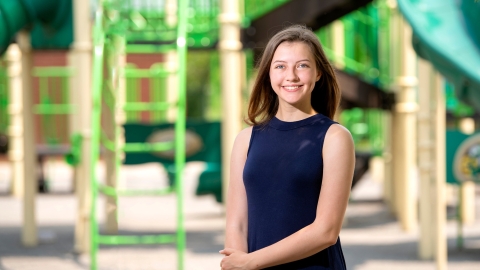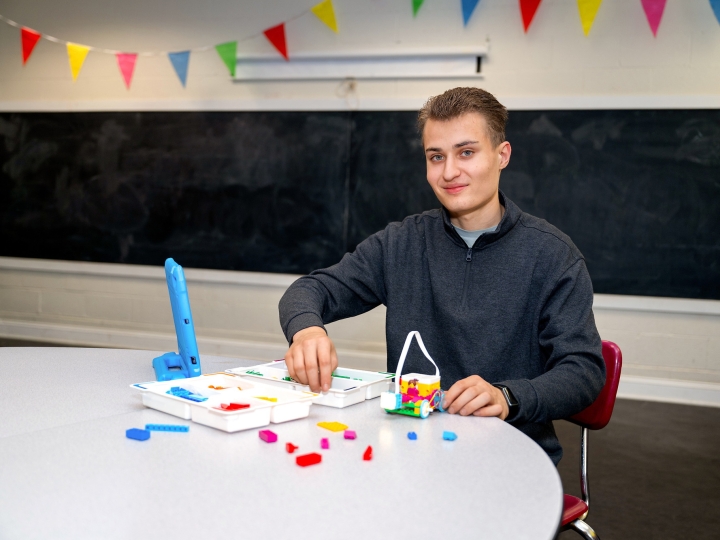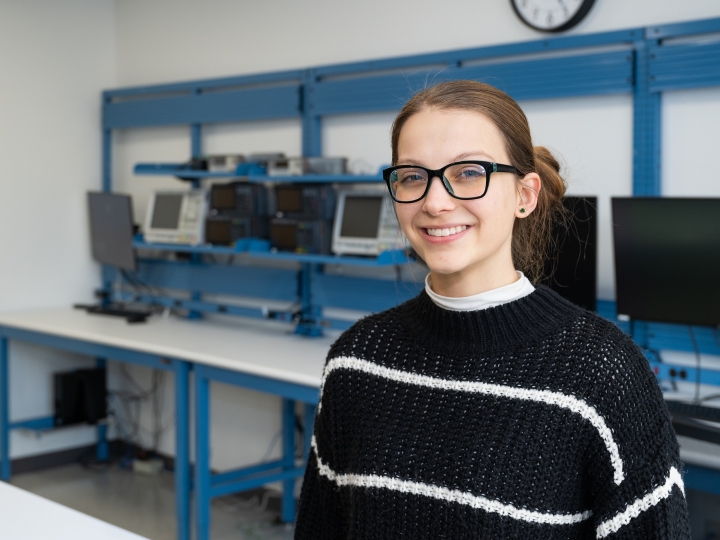
Brooke Ewer ’24, Biomedical Engineering
July 28, 2021
Brooke Ewer '24, a biomedical engineering major from Stanhope, N.J., is examining how building playgrounds on different types of surfaces can contribute to or help minimize injuries. Photo by Emily Paine, Communications
Somewhere in the swarm of children energetically climbing, swinging and sliding was an unexpected sight: a college student walking methodically through a playground, taking notes on a clipboard.
That conspicuous visitor was Brooke Ewer '24, a biomedical engineering major from Stanhope, N.J., who was collecting observations for a research project on playground safety.
Ewer's presence among the monkey bars and bright-plastic slides soon drew the attention of a 6-year-old boy who started following her around.
"I guess he was just really interested in why this college kid was wandering around his playground," Ewer says. "He said, 'Come, follow me. Let me show you this. Look how fast they go down the slide.' And while it did distract me a little bit, I really didn't mind. It reminded me why I'm doing this — because I want to help kids."
Upending expectations has been a critical part of Ewer's Bucknell experience so far. In her first year here, she was pleasantly surprised to see every door swing wide open. Professors were approachable, older students were welcoming and labs were accessible, even to new students like her.
"One of the labs I was shown on my tour is where I had a class my first year," she says. "It wasn't like the tour showcased something that I wouldn't see until later on down the road."
Researching the Researchers
Ewer also had day-one access to research opportunities. As soon as she got accepted to Bucknell, she started looking up her professors to see what they were studying.
She soon found Professor Eric Kennedy, biomedical engineering, who is examining how building playgrounds on different types of surfaces can contribute to or help minimize injuries.
To deliver accurate and repeatable measurements, Kennedy and his students use a $15,000 device called a TRIAX 15, which Bucknell uses on loan from the National Program for Playground Safety at the University of Northern Iowa. The equipment looks like a large metal shell hanging from a tripod that can be raised up to 12 feet high.
Researchers position the device at the same height as the monkey bars, the top of the slide and other positions from which a child could fall. Then they use a Bluetooth controller to send the 10-pound TRIAX plummeting toward the surface below.
The TRIAX sends back something called a HIC score — or head injury criterion score — which is the standard used to quantify risks of head injury in events like car accidents, helmet-to-helmet tackles and falls onto playground surfaces.
While the final results aren't yet in, Ewer says she was surprised to see mulch and sand perform better than surfaces like rubber tiles. Ewer and her fellow researchers will use this data to create safety guidelines for places that install playgrounds — locations like schools and daycares that likely can't afford a $15,000 gadget.
Work That's Rewarding
Helping others is what drew Ewer to biomedical engineering in the first place.
"All engineers help people," she says. "But there's something very empathetic and direct with a biomedical engineer. Being able to work with people is really rewarding."
Bucknell's strong biomedical engineering program (ranked No. 1 among undergraduate schools by U.S. News & World Report) ultimately led Ewer to apply, but the University wasn't on her initial college list.
Growing up in a small town, Ewer went to school with the same 30 kids from preschool until eighth grade, when she moved to an only slightly larger school of about 100 students per grade. It was the kind of community where everyone knew everyone. Ewer, a varsity soccer player, even babysat for her coach's kids.
Once it was time to research colleges, Ewer first looked at schools on the other end of the spectrum from what she knew.
"I thought I wanted to go to a big football school, because that was the culture I thought I wanted," she says. But she soon gravitated toward schools where she'd be "a name, not a number."
That led her to add some smaller schools, including Bucknell, to her list. One day, she emailed Biomedical Engineering Department Chair Dan Cavanagh with a few questions about Bucknell's program. He answered quickly.
Months later, Ewer visited campus during an open house and met Cavanagh in person.
"He was like, 'Oh, you're Brooke, right?' So that was really cool," she says. "I wasn't even a student. I hadn't yet applied. But they recognized me and remembered me. And that was very much a sign of things to come."

